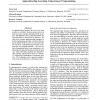357 search results - page 14 / 72 » Solving Generalized Maximum Dispersion with Linear Programmi... |
DISOPT
2008
13 years 7 months ago
2008
A pseudolattice L is a poset with lattice-type binary operations. Assuming that the pseudolattice permits a modular representation as a family of subsets of a set U with certain c...
SIAMMAX
2010
13 years 2 months ago
2010
Abstract. Linear inverse problems with uncertain measurement matrices appear in many different applications. One of the standard techniques for solving such problems is the total l...
ICML
2008
IEEE
14 years 8 months ago
2008
IEEE
In apprenticeship learning, the goal is to learn a policy in a Markov decision process that is at least as good as a policy demonstrated by an expert. The difficulty arises in tha...
NIPS
2007
13 years 9 months ago
2007
Loopy belief propagation has been employed in a wide variety of applications with great empirical success, but it comes with few theoretical guarantees. In this paper we investiga...
IJON
2002
13 years 7 months ago
2002
In this paper, the N-bit parity problem is solved with a neural network that allows direct connections between the input layer and the output layer. The activation function used i...


